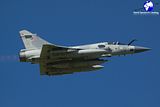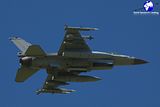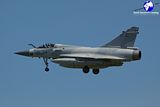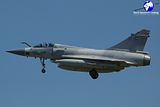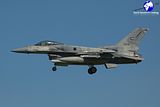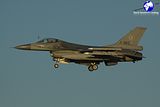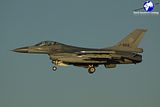After reaching a peak of 107 air strike sorties on Mar. 27, the number of bombing missions dropped. The reason, if you check the figures seems to be that NATO has continued conducting more or less the same number of strike sorties even after US withdrew their bombers. For instance, on Mar. 27, the US flew 52 air strikes and coalition flew 55 air strikes that is around the average count of sorties flown by NATO since US put their bombers on stand-by status. So, a quick examination of this figures show that NATO has not filled the gap whe US withdrew, or at least it hasn’t completely filled it.
In the meanwhile, according to NATO, multiple air strikes targeted communications infrastructure and the headquarters of Gaddafi’s 32nd brigade 10 km to the south of Tripoli.
“NATO will continue its campaign to degrade the Gaddafi regime forces that are involved in the ongoing attacks on civilians,” the commander of the NATO operation, Lieutenant-General Charles Bouchard, said.
The question is: how long will it take considering the current sortie ratio?
Other interesting things, information and thoughts:
1) Italian Minister of Defense La Russa explained to Sec Def. Robert Gates that Italy will not change its mission and will not supply more planes to Unified Protector. Hence, the Italian pilots will continue flying “airshow” sorties and there will be no Tornado IDS dropping PGMs in Libya. I still can’t understand what will happen if/when a Tornado ECR will detect an active SAM radar site and will be asked to hit it with an AGM-88 HARM missile…..
Do you think it’s not going to happen because there are no more active radar sites in Libya? Yesterday, an US F-16CJ hit and destroyed 2 SAM sites near Tripoli in a SEAD mission bringing to 8 the total SEAD strikes since Apr. 1.
In the meanwhile, in the previous 24 hrs, the Italian contingent flew 5 missions (2 sorties each): 1x Tornado, 3x Typhoon, 1x AV-8B Harrier from Cavour aircraft carrier.
2) Giuliano Ranieri, after checking on Google Earth the location of a NATO air strike asked me what are the shelters almost hidden in the desert around coordinates 31°41’44.48″N 12°19’54.25″E. I wonder if they could be related to the underground storage facilities I wrote about yesterday and, while I hope that some of those OSINT experts reading this blog will be able to explain me what’s stored inside those shelters, I suggest you reading another old article that Richard Clements found and brought once again to my attention: Libya’s “Secret tunnels of death”.
Operation Unified Protector (was Odyssey Dawn) explained (Day 30) April 18, 2011
Posted by David Cenciotti in Aviation, Italian Air Force, Libyan Uprising, Military Aviation, Operation Odyssey Dawn, Operation Unified Protector.
Tags: 155° Gruppo, 50° Stormo, A-10, A310, aar, Aeronautica Militare, AEW,AGM-88, air-to-air refueling, Airborne Early Warning, Allied Force, AMI, Armée de l'Air, ATCC, Aviano, AWACS, B-1, B-2, B707, Belgian Air Force, Benghazi,C-135FR, Canadian Air Force, CC-150, CF-18, Decimomannu, Deliberate Force, E-3F, EA-18G, EF-18, Electronic Warfare, Ellsworth, Eurofighter, EW, F-15E, F-16, Growler, Hornet, JAS-39, JSTAR, KC-130J, Laser Guided Bombs,LGB, Libya, Libyan uprising, Mirage 2000, NATO, Odyssey Dawn, Operation Ellamy, Operation Harmattan, Operation Mobile, Pantelleria, PGM, Piacenza,Precision Guided Munitions, Qatar Emiri Air Force, QEAF, RAF Marham, Rafale,RDAF, RoNAF, Royal Danish Air Force, Royal Norwegian Air Force, SA-6, SA-8,SAM, SEAD, Sentinel, SIGINT, Sigonella, Souda Bay, Spanish Air Force, stand-off missile, Suppression of Enemy Air Defences, Surface to Air Missile, Swedish Air Force, Tactical Recovery of Aircraft and Personnel, TLAM, Tomahawk,Tomahawk Land Attack Missile, Tornado, Tornado ECR, Tornado GR4, TRAP,Trapani, TuAF, Turkish Air Force, Typhoon, UAE AF, UAE Air Force, United States Air Force Europe, USAFE, Vancouver, Wild Weasel
4 comments
Tags: 155° Gruppo, 50° Stormo, A-10, A310, aar, Aeronautica Militare, AEW,AGM-88, air-to-air refueling, Airborne Early Warning, Allied Force, AMI, Armée de l'Air, ATCC, Aviano, AWACS, B-1, B-2, B707, Belgian Air Force, Benghazi,C-135FR, Canadian Air Force, CC-150, CF-18, Decimomannu, Deliberate Force, E-3F, EA-18G, EF-18, Electronic Warfare, Ellsworth, Eurofighter, EW, F-15E, F-16, Growler, Hornet, JAS-39, JSTAR, KC-130J, Laser Guided Bombs,LGB, Libya, Libyan uprising, Mirage 2000, NATO, Odyssey Dawn, Operation Ellamy, Operation Harmattan, Operation Mobile, Pantelleria, PGM, Piacenza,Precision Guided Munitions, Qatar Emiri Air Force, QEAF, RAF Marham, Rafale,RDAF, RoNAF, Royal Danish Air Force, Royal Norwegian Air Force, SA-6, SA-8,SAM, SEAD, Sentinel, SIGINT, Sigonella, Souda Bay, Spanish Air Force, stand-off missile, Suppression of Enemy Air Defences, Surface to Air Missile, Swedish Air Force, Tactical Recovery of Aircraft and Personnel, TLAM, Tomahawk,Tomahawk Land Attack Missile, Tornado, Tornado ECR, Tornado GR4, TRAP,Trapani, TuAF, Turkish Air Force, Typhoon, UAE AF, UAE Air Force, United States Air Force Europe, USAFE, Vancouver, Wild Weasel
4 comments
Previous debriefings:
- Day 1
- Day 2
- Day 3
- Day 4
- Day 5
- Day 6
- Day 7
- Day 8
- Day 9
- Day 10
- Day 11
- Day 12
- Day 13
- Day 14
- Day 15
- Day 16
- Day 17
- Day 18
- Day 19
- Day 20
- Day 21
- Day 22
- Day 23
- Day 24
- Day 25
- Day 26
- Day 27
- Day 28
- Day 29
A notice to the readers after 30 days of reports: I’m still deciding when the daily debriefs will have to switch to a weekly update. The amount of data and interesting facts is in fact decreasing each day while the comments you leave on each debrief and the email I receive are so interesting that they require a better analysis and more in-depth replies. For this reason, I suggest you reading the comments and replies on each debrief to follow the discussions that sometimes have become a continuation which add more interesting details to the daily reports.
In the meanwhile, beginning tomorrow, you’ll find the list of links to the previous reports on a dedicated page whose link will be the only one preceeding the daily recap. This should make the text easier to read (at least there will be no need to scroll down the page to find the beginning of the article).
Day 30 recap
The situation has not changed since Day 29. Interviewed by Al Jazeera, Major General Abdul Fatah Younis, commander of rebels troops in Libya called on NATO for “a more effective performance” saying that insurgents would break the siege of Misratah, if they receive gunship helicopters. Explaining that 6 Libyan military vehicles were hit during the battles between Ajdabiya and Brega, he said that they were destroyed by the “Ali al-Jabir brigade” of the Libyan rebel fighters: looks like the insurgents are at least somehow organized, with some brigades. As reported by AJE, commenting the fierce battles of Apr. 16, Gen. Abdul Fattah Younis said:
Targets were given for NATO to take out. Our forces then moved towards the east of Brega. We were surprised by a massive attack against us even though NATO had assured us there was no one there. We pulled back and directed NATO where to attack but they didn’t do anything.
Clearly, there must be some sort of poor coordination between NATO and rebel forces in spite of the small British military team, acting as a liaison team between rebels and NATO and advising anti-Gaddafi fighters on how to organise their command structure and communications.
A sandstorm (this time witnessed by local reporters…) prevented NATO planes from targeting Gaddafi’s forces allowing them to advance once again on the western edge of the city of Ajdabiya. Allies bombed Al-Hira, 50km south west of Tripoli and Sirte where probably the weather was better.
Needless to say, Misratah is still under heavy shelling: according to some source 1.000 died and 3.000 were wounded (80% civilians) in the loyalists attacks of the last weeks.
Other interesting things, information and thoughts:
1) Many readers and Twitter followers asked me to prepare a graph showing the trend in the air strikes vs overall sorties since the beginning of Unified Protector. Using the figures released by NATO, I prepared the following simple graphs which show a slight decrease in the number of air strikes flown by the allies in Libya. Noteworthy, on average, no more than 40% of sorties are air strikes: considering that “strike sorties are intended to identify and engage appropriate targets, but do not necessarily deploy munitions each time”, the amount of firepower dedicated to the enforcement of the NFZ (meaning fighters in Combat Air Patrol with air-to-air missiles) is excessive if compared to that capable of bombing ground targets, especially if we think to the almost complete lack of Libyan Arab Republic Air Force activity.
Since figures released by NATO refer to “the previous 24 hours” embracing 2 different dates, I thought it was better to use the release date as a reference.
Date released | Total sorties | Air strikes | air strikes/total |
1-apr | 178 | 74 | 42% |
2-apr | 174 | 74 | 43% |
3-apr | 184 | 70 | 39% |
4-apr | 154 | 58 | 38% |
5-apr | 150 | 58 | 39% |
6-apr | 155 | 66 | 43% |
7-apr | 164 | 73 | 45% |
8-apr | 155 | 54 | 35% |
9-apr | 156 | 60 | 39% |
10-apr | 133 | 56 | 43% |
11-apr | 154 | 70 | 46% |
12-apr | 158 | 59 | 38% |
13-apr | 159 | 60 | 38% |
14-apr | 153 | 58 | 38% |
15-apr | 146 | 60 | 42% |
16-apr | 145 | 58 | 40% |
17-apr | 144 | 42 | 30% |
2) Richard Clements sent me the link to an interesting article, titled “Mysterious Libyan Pipeline Could Be Conduit for Troops”, published in Dec. 1997 by the NYT (you can read it here on the FAS website).
Here’s an interesting excerpt:
A tunnel of pipes 4 meters, or 13 feet, in diameter is large enough to accommodate military vehicles, even a rail line. When the project is completed, Libya will have more than 2,000 miles of tunnel stretching from Tunisia to Egypt. In the south, it will reach almost to Sudan and Chad, a country with which Libya has tense relations.Every 50 to 60 miles along the pipeline, huge underground storage areas are being constructed, and the engineers said they are more elaborate than would be needed for holding water. The facilities, made of reinforced concrete, would be suitable for bivouacking troops or storing military supplies, including poison gas, the engineers said.While the system of pipelines does not by itself change the military balance in the region, it provides Col. Moammar Gadhafi, the Libyan leader, extensive opportunities to conceal his activities from the American spy satellites that pass overhead each day.“This is the first real evidence of something which has been suspected for several years,” Paul Beaver, a defense and intelligence analyst with Jane’s Defense Weekly, said when told of the engineers’ descriptions of the project. “Gadhafi seems to have taken a leaf out of Kim Il Sung’s book and created a potential military arsenal underground,” he added, referring to the late North Korean dictator.North Korea has an elaborate underground military system with storage facilities and tunnel routes for vehicles and troops. Beaver, a former British army officer with intelligence expertise, said that the tunnel system would allow Gadhafi to conceal troop movements, gain an element of surprise over an enemy, and protect his own troops from pre-emptive strikes.Other analysts are alarmed because the pipeline runs through a mountain called Tarhuna. This is where Gadhafi is constructing a chemical and biological weapons plant, American and European intelligence officials have said.
I don’t know if the underground storage was finished, however, the article reminded me of a few articles I’ve read of Italian workers describing Libyan underground military facilities in the desert. Even Tom Cooper of ACIG.org once told me something about a “huge underground depot” capable of containing an entire squadron of aircraft. The problem is not only what these storages contain, but how the hidden material could be used. Gaddafi’s forces have already bombed their own people with cluster bombs, what if they are able to collect chemical weapons possibly sheltered in one of these underground storage facilities?
Operation Unified Protector (was Odyssey Dawn) explained (Day 29) April 17, 2011
Posted by David Cenciotti in Aviation, Italian Air Force, Libyan Uprising, Military Aviation, Operation Odyssey Dawn, Operation Unified Protector.
Tags: 155° Gruppo, 50° Stormo, A-10, A310, aar, Aeronautica Militare, AEW,AGM-88, air-to-air refueling, Airborne Early Warning, Allied Force, AMI, Armée de l'Air, ATCC, Aviano, AWACS, B-1, B-2, B707, Belgian Air Force, Benghazi,C-135FR, Canadian Air Force, CC-150, CF-18, Decimomannu, Deliberate Force, E-3F, EA-18G, EF-18, Electronic Warfare, Ellsworth, Eurofighter, EW, F-15E, F-16, Growler, Hornet, JAS-39, JSTAR, KC-130J, Laser Guided Bombs,LGB, Libya, Libyan uprising, Mirage 2000, NATO, Odyssey Dawn, Operation Ellamy, Operation Harmattan, Operation Mobile, Pantelleria, PGM, Piacenza,Precision Guided Munitions, Qatar Emiri Air Force, QEAF, RAF Marham, Rafale,RDAF, RoNAF, Royal Danish Air Force, Royal Norwegian Air Force, SA-6, SA-8,SAM, SEAD, Sentinel, SIGINT, Sigonella, Souda Bay, Spanish Air Force, stand-off missile, Suppression of Enemy Air Defences, Surface to Air Missile, Swedish Air Force, Tactical Recovery of Aircraft and Personnel, TLAM, Tomahawk,Tomahawk Land Attack Missile, Tornado, Tornado ECR, Tornado GR4, TRAP,Trapani, TuAF, Turkish Air Force, Typhoon, UAE AF, UAE Air Force, United States Air Force Europe, USAFE, Vancouver, Wild Weasel
2 comments
Tags: 155° Gruppo, 50° Stormo, A-10, A310, aar, Aeronautica Militare, AEW,AGM-88, air-to-air refueling, Airborne Early Warning, Allied Force, AMI, Armée de l'Air, ATCC, Aviano, AWACS, B-1, B-2, B707, Belgian Air Force, Benghazi,C-135FR, Canadian Air Force, CC-150, CF-18, Decimomannu, Deliberate Force, E-3F, EA-18G, EF-18, Electronic Warfare, Ellsworth, Eurofighter, EW, F-15E, F-16, Growler, Hornet, JAS-39, JSTAR, KC-130J, Laser Guided Bombs,LGB, Libya, Libyan uprising, Mirage 2000, NATO, Odyssey Dawn, Operation Ellamy, Operation Harmattan, Operation Mobile, Pantelleria, PGM, Piacenza,Precision Guided Munitions, Qatar Emiri Air Force, QEAF, RAF Marham, Rafale,RDAF, RoNAF, Royal Danish Air Force, Royal Norwegian Air Force, SA-6, SA-8,SAM, SEAD, Sentinel, SIGINT, Sigonella, Souda Bay, Spanish Air Force, stand-off missile, Suppression of Enemy Air Defences, Surface to Air Missile, Swedish Air Force, Tactical Recovery of Aircraft and Personnel, TLAM, Tomahawk,Tomahawk Land Attack Missile, Tornado, Tornado ECR, Tornado GR4, TRAP,Trapani, TuAF, Turkish Air Force, Typhoon, UAE AF, UAE Air Force, United States Air Force Europe, USAFE, Vancouver, Wild Weasel
2 comments
Previous debriefings:
- Day 1
- Day 2
- Day 3
- Day 4
- Day 5
- Day 6
- Day 7
- Day 8
- Day 9
- Day 10
- Day 11
- Day 12
- Day 13
- Day 14
- Day 15
- Day 16
- Day 17
- Day 18
- Day 19
- Day 20
- Day 21
- Day 22
- Day 23
- Day 24
- Day 25
- Day 26
- Day 27
- Day 28
Once again “stalemate” is the most used term to define the situation on the battlefield in Libya. Misratah is still under siege as Gaddafi’s forces pounded the third largest Libyan city with rocket, mortars and cluster bombs used also on residential areas. Loyalist are attacking food industry plants in Misrata including a dairy as well as a cooking oil one while tanks entered the city pushing civilians closer to the port area. More often Misratah is referred to as a new or mini-Stalingrad after the famous city which saw Soviet troops resisting to the Nazis for almost 6 months in a house-to-house fighting that took place with complete disregard of military and civilian casualties. If that for Stalingrad was one of the bloodest battle in WWII, Misratah is where rebels, outnumbered by pro-Government troops, are resisting from more than 6 weeks of street-fighting.
Insurgents made another effort to push towards Brega oil terminal and 6 were killed and more than 20 wounded when loyalist fired rockets on the rebel vehicles along the coastal highway, from Ajdabiyah westward to Brega. In Ajdabiyah, oppositors said Gaddafi’s forces were positioned in the center of Brega, sometimes inside houses, while rebels were more exposed.
During Day 29, the number of sorties conducted by NATO dropped to 144, 42 of which were strike ones. Since the beginning of the NATO operation (31 March 2011, 08.00GMT) a total of 2.734 sorties and 1.146 strike sorties have been conducted (as always, strike sorties are intended to identify and engage appropriate targets, but do not necessarily deploy munitions each time). I’m still not sure if reconnaissance sorties count as strike sorties or not.
The key targets hit were 2 ammunition bunkers destroyed, one Surface-to-air anti-aircraft site destroyed in the vicinity of Tripoli, 1 Armoured Personnel Carrier destroyed in the vicinity of Misrata, 2 tanks, 2 equipment transporters, 1 artillery piece, 1 tank transporter, 4 ammunition storage sites and one ammunition bunker destroyed in the vicinity of Sirte and 1 ammunition storage site damaged near Zintan.
Considering the type of battle being fought in and around Misratah, isn’t a single APC destroyed not enough to avoid the massacre in the strategic city?
Source: Twitpic
Other interesting things, information and thoughts:
1) Many are still asking why NATO is not doing enough to prevent civilians being literally slaughtered by Gaddafi’ snipers and heavy artillery. According to the Washington Post, one of the reasons is that NATO is running short of PGMs. Below you can find an excerpt of the article:
NATO runs short on some munitions in LibyaBy Karen DeYoung and Greg Jaffe, Friday, April 15, 8:46 PMLess than a month into the Libyan conflict, NATO is running short of precision bombs, highlighting the limitations of Britain, France and other European countries in sustaining even a relatively small military action over an extended period of time, according to senior NATO and U.S. officials.The shortage of European munitions, along with the limited number of aircraft available, has raised doubts among some officials about whether the United States can continue to avoid returning to the air campaign if Libyan leader Moammar Gaddafi hangs on to power for several more months.[...]But, they said, the current bombing rate by the participating nations is not sustainable. “The reason we need more capability isn’t because we aren’t hitting what we see — it’s so that we can sustain the ability to do so. One problem is flight time, the other is munitions,” said another official, one of several who were not authorized to discuss the issue on the record.European arsenals of laser-guided bombs, the NATO weapon of choice in the Libyan campaign, have been quickly depleted, officials said. Although the United States has significant stockpiles, its munitions do not fit on the British- and French-made planes that have flown the bulk of the missions.Britain and France have each contributed about 20 strike aircraft to the campaign. Belgium, Norway, Denmark and Canada have each contributed six — all of them U.S.-manufactured and compatible with U.S. weaponry.[...]But with Gaddafi’s forces and the rebel army locked in a stalemate, Obama has resisted calls from opposition leaders, and some hardline lawmakers in this country, to move U.S. warplanes back into a leading role.Sen. John McCain (R-Ariz.) and other have called on Obama to redeploy U.S. AC-130 gunships, which are considered more effective over populated areas.Although the gunships flew several missions early in the operation, Gen. Carter Ham, who commanded the mission before it was turned over to NATO, said last week that they were frequently grounded because of weather and other concerns.The slow-moving aircraft, which flew as low as 4,000 feet over Libya, are also considerably more vulnerable than jet fighters to surface-to-air missiles. While much of Libya’s stationary air defenses have been destroyed, Ham said Gaddafi was believed to have about 20,000 shoulder-held SAMS at the beginning of the conflict, and “most” of them are still unaccounted for.Concerns that supplies of jet-launched precision bombs are growing short in Europe have reignited long-standing controversies over both burden-sharing and compatibility within NATO. While allied jets have largely followed the U.S. lead and converted to precision munitions over the last decade, they have struggled to keep pace, according to senior U.S. military officials.Libya “has not been a very big war. If [the Europeans] would run out of these munitions this early in such a small operation, you have to wonder what kind of war they were planning on fighting,” said John Pike, director of GlobalSecurity.org, a defense think tank. “Maybe they were just planning on using their air force for air shows.”Despite U.S. badgering, European allies have been slow in some cases to modify their planes and other weapons systems so they can accommodate U.S. bombs. Retooling these fighter jets so that they are compatible with U.S. systems requires money, and all European militaries have faced significant cuts in recent years.Typically, the British and French militaries buy munitions in batches and stockpile them. When arsenals start to run low, factories must be retooled and production lines restarted to replace the diminished stock, all of which can take time and additional money, said Elizabeth Quintana, an aerospace analyst at the Royal United Service Institute in London.deyoungk@washpost.comjaffeg@washpost.comCorrespondent Simon Denyer in Tripoli contributed to this report.
I don’t know which countries are already short of LGBs but most probably among those actively involved in the air strike some might be nearing the end of their stocks. The RDAF alone (one of the most active contingents in Unified Protector) has dropped more than 200 PGMs. If we consider that orders for (quite expensive) ordnance are usually placed by European countries for a few hundred bombs at one time or for quantities lower than 1.000 pieces (as, fortunately, LGBs are not used very often in peacetime), those that are involved in both Afghanistan from some years and now in Libya might be in the need to replenish their stocks in the future, but most probably not yet after just 28 days of operations.
Noteworthy, the article underlines that European air forces should modify their planes to accomodate US bombs even if in most (if not all) cases, US and NATO PGMs (both LGBs and GPS-guided bombs) can be attached to the standard pylons and rails without the need of any modification. For sure there are some weapons that were “locally-developed” and don’t fit with standard bomb racks or suspension lugs but the large majority of the ordnance carried by the aircraft is “NATO standard”, as the extensive use of GBU-12s (described in the previous reports) and GBU-38s shows.
2) The number of Italian missions flown in the last 24 hours dropped to 3, each flown by pairs: 2x AV-8Bs and 1x Tornados (not clear if ECRs or IDSs).
3) A couple of days ago I reported of the speculations about an increased activity of US assets in Aviano. After investigating the rumours, I discovered that activity of US aircraft supporting Unified Protector has decreased. The USN Growlers, as already explained, are flying single ship one sortie per day. The F-16CJs are flying 1 mission per day (2 sorties). On a daily basis, even the RJAF F-16s are flying a single mission with 2 aircraft, lasting on average 5 – 6 hours. Still on the ground, not flying from days, on stand by, there should be no more than 4 F-15Es and 4 A-10s.
4) Aksel Magdahl informed me that as of Apr. 15, the RNoAF flew 81 missions under Unified Protector (even if it is not clear whether it is a total comprising Odyssey Dawn or just since UP has begun).
Operation Unified Protector (was Odyssey Dawn) explained (Day 28) April 16, 2011
Posted by David Cenciotti in Aviation, Italian Air Force, Libyan Uprising, Military Aviation, Operation Odyssey Dawn, Operation Unified Protector.
Tags: 155° Gruppo, 50° Stormo, A-10, A310, aar, Aeronautica Militare, AEW,AGM-88, air-to-air refueling, Airborne Early Warning, Allied Force, AMI, Armée de l'Air, ATCC, Aviano, AWACS, B-1, B-2, B707, Belgian Air Force, Benghazi,C-135FR, Canadian Air Force, CC-150, CF-18, Decimomannu, Deliberate Force, E-3F, EF-18, Electronic Warfare, Ellsworth, Eurofighter, EW, F-15E, F-16, Hornet, JAS-39, JSTAR, KC-130J, Laser Guided Bombs, LGB, Libya, Libyan uprising, Mirage 2000, NATO, Odyssey Dawn, Operation Ellamy, Operation Harmattan, Operation Mobile, Pantelleria, PGM, Piacenza, Precision Guided Munitions, Qatar Emiri Air Force, QEAF, RAF Marham, Rafale, RDAF, RoNAF,Royal Danish Air Force, Royal Norwegian Air Force, SA-6, SA-8, SAM, SEAD,Sentinel, SIGINT, Sigonella, Souda Bay, Spanish Air Force, stand-off missile,Suppression of Enemy Air Defences, Surface to Air Missile, Swedish Air Force,Tactical Recovery of Aircraft and Personnel, TLAM, Tomahawk, Tomahawk Land Attack Missile, Tornado, Tornado ECR, Tornado GR4, TRAP, Trapani,TuAF, Turkish Air Force, Typhoon, UAE AF, UAE Air Force, United States Air Force Europe, USAFE, Wild Weasel
1 comment so far
Tags: 155° Gruppo, 50° Stormo, A-10, A310, aar, Aeronautica Militare, AEW,AGM-88, air-to-air refueling, Airborne Early Warning, Allied Force, AMI, Armée de l'Air, ATCC, Aviano, AWACS, B-1, B-2, B707, Belgian Air Force, Benghazi,C-135FR, Canadian Air Force, CC-150, CF-18, Decimomannu, Deliberate Force, E-3F, EF-18, Electronic Warfare, Ellsworth, Eurofighter, EW, F-15E, F-16, Hornet, JAS-39, JSTAR, KC-130J, Laser Guided Bombs, LGB, Libya, Libyan uprising, Mirage 2000, NATO, Odyssey Dawn, Operation Ellamy, Operation Harmattan, Operation Mobile, Pantelleria, PGM, Piacenza, Precision Guided Munitions, Qatar Emiri Air Force, QEAF, RAF Marham, Rafale, RDAF, RoNAF,Royal Danish Air Force, Royal Norwegian Air Force, SA-6, SA-8, SAM, SEAD,Sentinel, SIGINT, Sigonella, Souda Bay, Spanish Air Force, stand-off missile,Suppression of Enemy Air Defences, Surface to Air Missile, Swedish Air Force,Tactical Recovery of Aircraft and Personnel, TLAM, Tomahawk, Tomahawk Land Attack Missile, Tornado, Tornado ECR, Tornado GR4, TRAP, Trapani,TuAF, Turkish Air Force, Typhoon, UAE AF, UAE Air Force, United States Air Force Europe, USAFE, Wild Weasel
1 comment so far
Previous debriefings:
- Day 1
- Day 2
- Day 3
- Day 4
- Day 5
- Day 6
- Day 7
- Day 8
- Day 9
- Day 10
- Day 11
- Day 12
- Day 13
- Day 14
- Day 15
- Day 16
- Day 17
- Day 18
- Day 19
- Day 20
- Day 21
- Day 22
- Day 23
- Day 24
- Day 25
- Day 26
- Day 27
“We will not take part in the air strikes as Italy is a former colonial power in Libya”. Italian PM Silvio Berlusconi words, backed by similar statements by both the Foreign and Defense Ministers, explained on Apr. 15 the attitude of Italy towards improving its contribution to Unified Protector, the NATO led mission in the North African country. Along with the 7 deployment airbases rendered available to the allies, 12 aircraft and4 ships were transferred under NATO command to enforce the NFZ over Libya and the arms embargo. However, although allies urged other partners to supply more combat planes capable of performing air strikes, Italy ruled out clearing its planes to drop bombs as well as the possibility of assigning to NATO more aircraft. Differently, Italy will also reconsider its participation in some of the expensive overseas missions, like the one in Lebanon.
It still remains unclear whether the “no clearance to engage” applies also to the Tornado ECRs involved in SEAD strikes or not: considering the suppression of the enemy air defenses a defensive rather than offessive mission, it is reasonable to think that the Italian planes would fire their HARM missiles if needed to shut down a Libyan radar site, otherwise, the number of missions flown by the 155° Gruppo “Panthers” since Mar. 19 would be only an unbelievable waste of money (time, fuel, etc.).
As already explained in the previous Debriefs, Italy was one of the key candidates to increase NATO firepower: the Tornados are already deployed to Trapani, headquarters of the Italian Air Force Task Group Air, to perform reconnaissance and buddy air-to-air refueling, hence there would have been no need to relocate if Italy had decided to contribute with more aircraft.
A similar decision was taken by Spain that has said it doesn’t intend to give its F-18s the order to change their role and to employ its Hornets against ground targets. Other partner that could be called to provide more firepower are the Netherlands and Sweden with the latter already partially involved in the air to ground role with the JAS-39 Gripen (not dropping bombs, but at least identifying targets for air strikes within reconnaissance missions).
While NATO partners discuss if it is better to enlarge the fleet of planes capable of attacking Libyan ground targets rather than supplying rebels with arms, Gaddafi’s forces have intensified their attacks with rockets and heavy artillery on the besieged Misratah where allies performed a few attacks. NATO attacked also Tripoli, striking a missile battery and two other targets in and around the capital city.
Dealing with the NATO operation, since the beginning of Unified Protector (31 March 2011, 08.00GMT) a total of 2,583 sorties and 1087 strike sorties were conducted. On Apr. 15, 145 sorties were flown, 58 of which were strikes. Among the key targets struck on Day 28: 5 bunkers in the vicinity of Sirte, 2 tanks in the vicinity of Zintan, 2 tanks in the vicinity of Misratah, and 4 bunkers in or around Tripoli. Interestingly, in the previous 24 hours (on Apr. 14) during the 60 of 146 sorties flown, the allied aircraft had hit 8 bunkers, 4 ammunition storages sites, 2 armoured personnel carriers in the vicinity of Sirte, 1 SA-3 radar and 1 SA-3 missile laucher in the vicinity of Tunisian border, 3 bunkers and 1 helicopter (probably on the ground) in the vicinity of Misratah and 2 ammunition storage sites, 1 radar and 1 tank in the vicinity of Tripoli. Clearly, some (mobile?) SAM sites can be still found in Libya.
Other interesting things, information and thoughts:
1) For the first time, Gaddafi’s forces used MAT-120 mortar-launched cluster bombs which were fired into populated areas. Although not accurate cluster bombs used in Misratah contains 21 bomblets capable of covering large areas (2/3 of a football field) posing civilian under serious risk and, for this reason, they were banned by those nations that ratified the Convention on Cluster Munitions, adopted in Dublin, Ireland in May 2008 (that became International law in 2010).
Source: NYT
2) According to the BBC, RAF Typhoons were not employed as efficiently as possible because, of the 48 pilots who are qualified on the Typhoon, only 8 can perform ground attacks. “Several other pilots are grounded as they could not make the required number of training hours because of a lack of spare parts for the aircraft”.
French MoD released a weekly update about Operation Harmattan. Since Apr. 7, the French military provides an average of 30 sorties, 120 flying hours a day, half of which are strike missions. These figures represent 20% of the overall NATO flying activity and 25% of all the air strikes conducted within Unified Protector.
Since April 7, 2011, the French military provides an average of thirty times a day, or about 120 hours of flying time, approximately half of the ground strike missions. Ces chiffres représentent 20% des sorties de l’OTAN et 25% des sorties d’attaques au sol. These figures represent 20% of the outputs of NATO and 25% of output ground attacks.
Between April 7, 2011 6:00 ET and April 14, 2011 0600, France has conducted:
- 96 air strike sorties ( Rafale Air, Mirage 2000-D et Mirage F1 CR / Rafale Marine et Super-Etendard Marine)
- 48 reconnaissance sorties ( Rafale Air, Mirage F1 CR et Rafale Marine / Reco NG)
- 22 air defense sorties ( Mirage 2000-5 from Souda Bay in cooperation with Qatar)
- 12 air space management (E3F and E2C)
- 33 air-to-air refueling sorties (C135 and Rafale Marine / Super Etendard Marine)
Furthermore, since Apr. 7, the air to ground activity of the French aircraft have neutralized around 20 targets, including 15 military vehicles, 2 SA-2, 5 pieces of artillery, multiple rocket launchers and a piece of anti-aircraft artillery. A command post near Sirte, and an ammunition depot between Brega and Adjabiya were also destroyed.
3) In the last days I explained that the Swedish Air Force was flying reconnaissance with what I thought was a Recce Lite pod. Actually, the one in the pictures was not a Recce Lite pod but a Litening pod: datalink antenna aside (that it is not always present underneath the pod), the two pods, sharing 70% of common parts, are impossible to distinguish each other.
Source: Internet (the Litening and Recce Lite pods. Identical (apart from the data link antenna, that is not always required).
Since the Gripen can carry the Recce Lite and this pod was used for tests in Sweden I thought that was the kind of recce pod used by the Swedish Gripens. However, a further investigation and the help of Karl-Johan Norén (a reader of this blog) and @GripenNews on Twitter enabled me to discover that the one used by the JAS-39 is the large MPRS with Spaningskapsel 39 (SPK39IV).
SweAF released some pictures, reduced in quality of imagery taken by the Gripens of the Okba Ibn Nafa SAM site near Tripoli.
Dealing with the Swedish mission (named Operation Karakal), the aircraft are flying two missions per day; so far 16 missions were flown from Apr. 7 to Apr. 13. The C-130 tanker (Swedish designation TP-84) suffered an engine transmission fault, and also a bird strike during the landing, requiring two days of repairs.
4) Yesterday I published a picture showing a Belgian Air Force F-16 with an LGB of the same type, even in terms of colors, of the one dropped on the rebels on Apr. 7. Jakob Knold noticed the same GBU-12s also on the RDAF F-16 as the following official Royal Danish Air Force pictures show.
5) The RNoAF has conducted 80 sorties dropping more than 100 PGMs Lieutenant, Colonel and senior spokesman John Espen Lien of the Armed Forces Operational Headquarters explained in an interview published on the Norwegian newspaper Dagbladet.
The 6 F-16s deployed to Souda Bay, Crete, are flying 4 to 8 sorties per day. They are mostly engaging ground targets with both laser guided and GPS guided bombs, even if some reconnaissance sorties were flown in the last days. For the RNoAF, that took part in Allied Force in Serbia in 1999, Unified Protector it’s the most intense air operation since WWII.
Operation Unified Protector (was Odyssey Dawn) explained (Day 27) April 15, 2011
Posted by David Cenciotti in Aviation, Military Aviation, Italian Air Force, Libyan Uprising, Operation Odyssey Dawn, Operation Unified Protector.
Tags: 155° Gruppo, 50° Stormo, A-10, A310, aar, Aeronautica Militare, AEW,AGM-88, air-to-air refueling, Airborne Early Warning, Allied Force, AMI, Armée de l'Air, ATCC, Aviano, AWACS, B-1, B-2, B707, Belgian Air Force, Benghazi,C-135FR, Canadian Air Force, CC-150, CF-18, Decimomannu, Deliberate Force, E-3F, EF-18, Electronic Warfare, Ellsworth, Eurofighter, EW, F-15E, F-16, Hornet, JAS-39, JSTAR, KC-130J, Laser Guided Bombs, LGB, Libya, Libyan uprising, Mirage 2000, NATO, Odyssey Dawn, Operation Ellamy, Operation Harmattan, Operation Mobile, Pantelleria, PGM, Piacenza, Precision Guided Munitions, Qatar Emiri Air Force, QEAF, RAF Marham, Rafale, RDAF, RoNAF,Royal Danish Air Force, Royal Norwegian Air Force, SA-6, SA-8, SAM, SEAD,Sentinel, SIGINT, Sigonella, Souda Bay, Spanish Air Force, stand-off missile,Suppression of Enemy Air Defences, Surface to Air Missile, Swedish Air Force,Tactical Recovery of Aircraft and Personnel, TLAM, Tomahawk, Tomahawk Land Attack Missile, Tornado, Tornado ECR, Tornado GR4, TRAP, Trapani,TuAF, Turkish Air Force, Typhoon, UAE AF, UAE Air Force, United States Air Force Europe, USAFE, Wild Weasel
7 comments
Tags: 155° Gruppo, 50° Stormo, A-10, A310, aar, Aeronautica Militare, AEW,AGM-88, air-to-air refueling, Airborne Early Warning, Allied Force, AMI, Armée de l'Air, ATCC, Aviano, AWACS, B-1, B-2, B707, Belgian Air Force, Benghazi,C-135FR, Canadian Air Force, CC-150, CF-18, Decimomannu, Deliberate Force, E-3F, EF-18, Electronic Warfare, Ellsworth, Eurofighter, EW, F-15E, F-16, Hornet, JAS-39, JSTAR, KC-130J, Laser Guided Bombs, LGB, Libya, Libyan uprising, Mirage 2000, NATO, Odyssey Dawn, Operation Ellamy, Operation Harmattan, Operation Mobile, Pantelleria, PGM, Piacenza, Precision Guided Munitions, Qatar Emiri Air Force, QEAF, RAF Marham, Rafale, RDAF, RoNAF,Royal Danish Air Force, Royal Norwegian Air Force, SA-6, SA-8, SAM, SEAD,Sentinel, SIGINT, Sigonella, Souda Bay, Spanish Air Force, stand-off missile,Suppression of Enemy Air Defences, Surface to Air Missile, Swedish Air Force,Tactical Recovery of Aircraft and Personnel, TLAM, Tomahawk, Tomahawk Land Attack Missile, Tornado, Tornado ECR, Tornado GR4, TRAP, Trapani,TuAF, Turkish Air Force, Typhoon, UAE AF, UAE Air Force, United States Air Force Europe, USAFE, Wild Weasel
7 comments
Previous debriefings:
- Day 1
- Day 2
- Day 3
- Day 4
- Day 5
- Day 6
- Day 7
- Day 8
- Day 9
- Day 10
- Day 11
- Day 12
- Day 13
- Day 14
- Day 15
- Day 16
- Day 17
- Day 18
- Day 19
- Day 20
- Day 21
- Day 22
- Day 23
- Day 24
- Day 25
- Day 26
What happened on Day 27 of Odyssey Dawn/Unified Protector can be summarized in the few words used by Al Jazeera English Libya Live Blog that, just past the midnight on Day 28, provided the following recap of the situation:
After two days of discussions and two high-level meetings over the past few hours, there appears to be little consensus on how to resolve the conflict in Libya.In the Egyptian capital Cairo, the United Nations and other major blocs have called for a political solution.While during a meeting in the German capital Berlin, NATO said it will continue military strikes for as long as it is necessary.
US secretary of state Hillary Clinton, said that the US military will “strongly support” the coalition until the work is completed and Gaddafi is dislodged. Even if someone thinks that Clinton’s words were a confirmation on a renewed involvement of the US in the air strikes, urged by the European diplomacy in the previous days, it seems that, at least for the moment, the Americans will continue supporting Unified Protector with the same assets already under NATO command. There are reports of increased activity at Aviano airbase, where the majority of the US bombers (F-15Es and A-10s) were (and still are) deployed but there’s no confirmation so far that the missions flown were directly related to the ops over Libya.
Misratah is still under siege, with local population and rebels asking for more NATO air strikes to avoid a massacre as the strategic town was blasted with a barrage of rockets, mortar fire and heavy artillery but, at the same time, the almost four-week old air campaign has failed to knock the Libyan leader off.
A fierce fighting is still taking place in Ajdabiya, where the AFP news agency reported that a convoy of 60 rebel vehicles came under heavy fire while, NATO air strikes were conduceted on Tripoli and at al-Assah, located about 170 km to the west of the capital city.
Furthermore, while allied bombs hit targets in downtown Tripoli on Apr. 14, Gaddafi patrolled the streets of the capital in an open-top vehicle with horns blazing as he waved to the people along the way.
Source: Reuters via AJE
Other interesting things, information and thoughts:
1) Although without providing as many details as one might expect, the Italian MoD is one of the few that is still providing a daily update on the missions flown for Unified Protector. During the last 24 hrs, the Italian contingent flew 6 missions with 2 aircraft each: 2x Tornados, 3x Typhoons, 1x Harriers from Garibaldi aircraft carrier.
2) For sure one of the most interesting detachment that is not releasing information on the number and type of mission flown for Unified Protector is the UAE AF one at Decimomannu. However the UAE F-16s and Mirage 2000s are attracting the interest of thousands spotters and aircraft enthusiasts from Europe, that are flying to Sardinia to see them departing and returning for their patrol flights, along with the Dutch F-16s operating from the same base. Below you can see some pictures taken at Decimomannu by Giovanni Maduli.
3) In the Day 21 Debrief, explaining that many had asked me to determine the plane involved in the blue-of-blue accident when a GBU-12 was dropped by a NATO aircraft on a rebel tank column advancing from Ajdabiyah to Brega, I wrote:
[...]So far, analyzing the pictures made available by both the various air forces involved and by AP, Getty etc., I think I’ve seen that type of LGB (same colors etc) attached to the CAF CF-18s [...], however, this obviously doesn’t mean that Canadian planes were involved in the friendly fire incident![...]
Finally, I’ve found a USAF picture showing another NATO aircraft, a Belgian Air Force F-16, carrying a GBU-12 of the same type, even in terms of colors, of the one dropped on the rebels on Apr. 7. The picture was not taken during Unified Protector, but during Enduring Freedom in Afghanistan but I think it is worth a mention since it shows, as explained, that not only the CAF uses that kind of LGB in Libya.
part 1 - the beginninghttp://egyptday1.blogspot.com/2011/04/operation-unified-protector-was-odyssey.html
Tags: 155° Gruppo, 50° Stormo, A-10, A310, aar, Aeronautica Militare, AEW,AGM-114 Hellfire, AGM-88, air-to-air refueling, Airborne Early Warning, Allied Force, AMI, Armée de l'Air, ATCC, Aviano, AWACS, B-1, B-2, B707, Belgian Air Force, Benghazi, Brimstone, C-135FR, Canadian Air Force, CC-150, CF-18,Decimomannu, Deliberate Force, E-3F, EA-18G, EF-18, Electronic Warfare,Ellsworth, Eurofighter, EW, F-15E, F-16, Growler, Hornet, JAS-39, JSTAR, KC-130J, Laser Guided Bombs, LGB, Libya, Libyan uprising, Mirage 2000, NATO,Odyssey Dawn, Operation Ellamy, Operation Harmattan, Operation Mobile,Pantelleria, PGM, Piacenza, Precision Guided Munitions, Predator, Qatar Emiri Air Force, QEAF, RAF Marham, Rafale, RDAF, RNoAF, RoNAF, Royal Danish Air Force, Royal Norwegian Air Force, SA-6, SA-8, SAM, Scud, SEAD, Sentinel,SIGINT, Sigonella, Sniper, Souda Bay, Spanish Air Force, stand-off missile,Suppression of Enemy Air Defences, Surface to Air Missile, Swedish Air Force,Tactical Recovery of Aircraft and Personnel, Targeting Pod, TLAM, Tomahawk,Tomahawk Land Attack Missile, Tornado, Tornado ECR, Tornado GR4, TRAP,Trapani, TuAF, Turkish Air Force, Typhoon, UAE AF, UAE Air Force, UAV, UCAV,United States Air Force Europe, USAFE, Wild Weasel



























